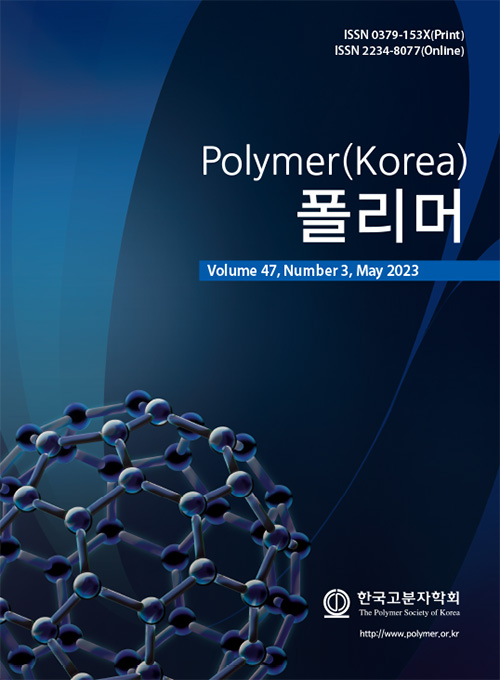- Heat Dissipation Material with Alumina Selectively Dispersed Using PS-PMMA Diblock Copolymer
Department of Polymer Science and Engineering, Pusan National University, 2, Busandaehak-ro 63beon-gil, Geumjeong-gu, Busan 46241, Korea
- PS-PMMA Diblock Copolymer를 이용하여 알루미나를 선택적으로 분산한 방열 소재
부산대학교 고분자공학과
Reproduction, stored in a retrieval system, or transmitted in any form of any part of this publication is permitted only by written permission from the Polymer Society of Korea.
In order to increase the thermal conductivity of the heat dissipation material, it is necessary to increase the content of alumina, a thermally conductive ceramic filler, and a typical heat dissipation material forms a continuous heat transfer path when the filler content is 50 wt% or more. However, as the content of the ceramic filler increases, the tensile strength of the heat dissipation material decreases, which is an obstacle to commercialization and market expansion. Therefore, in this study, a continuous heat transfer path was formed by selectively dispersing a thermally conductive filler using polystyrene-poly(methyl methacrylate) diblock copolymer and adding carbon nanotubes to an extent capable of maintaining electrical insulation to act as a heat transfer bridge between ceramic fillers. In the end, an electrically insulating heat dissipation material with improved thermal conductivity and tensile strength was manufactured by increasing the heat transfer efficiency of the thermally conductive ceramic filler to form a continuous heat transfer path even when the filler content is 50 wt% or less.
방열 소재의 열전도도를 높이기 위해서는 열전도성 세라믹 필러인 알루미나의 함량이 높아야 하며, 일반적인 방열 소재는 필러 함량이 50 wt% 이상에서 연속적인 열전달 경로를 형성한다. 하지만 세라믹 필러의 함량이 증가할수록 방열 소재의 인장 강도는 낮아지게 되고, 이는 방열 소재의 상용화 및 시장 확대의 장애 요인이 된다. 이에 본 연구에서는 polystyrene-poly(methyl methacrylate) diblock copolymer를 매트릭스로 도입하여 열전도성 필러를 선택적으로 분산시키고 전기절연성을 유지할 수 있는 정도의 탄소 나노 튜브를 첨가하여 세라믹 필러 간의 열전달 다리 역할을 하게 함으로써 연속적인 열전달 경로를 형성시켰다. 결국 열전도성 세라믹 필러의 열전달 효율을 높여 필러 함량이 50 wt% 이하에서도 연속적인 열전달 경로를 형성하도록 하여 열전도도와 인장 강도가 향상된 전기절연성 방열 소재를 제조하였다.
Keywords: heat dissipation material, polystyrene-poly(methyl methacrylate) diblock copolymer, composite, alumina, carbon nanotube.
- Polymer(Korea) 폴리머
- Frequency : Bimonthly(odd)
ISSN 0379-153X(Print)
ISSN 2234-8077(Online)
Abbr. Polym. Korea - 2023 Impact Factor : 0.4
- Indexed in SCIE
 This Article
This Article
-
2023; 47(3): 354-360
Published online May 25, 2023
- 10.7317/pk.2023.47.3.354
- Received on Jan 16, 2023
- Revised on Mar 10, 2023
- Accepted on Mar 14, 2023
 Correspondence to
Correspondence to
- Nam-Ju Jo
-
Department of Polymer Science and Engineering, Pusan National University, 2, Busandaehak-ro 63beon-gil, Geumjeong-gu, Busan 46241, Korea
- E-mail: namjujo@pusan.ac.kr









 Copyright(c) The Polymer Society of Korea. All right reserved.
Copyright(c) The Polymer Society of Korea. All right reserved.